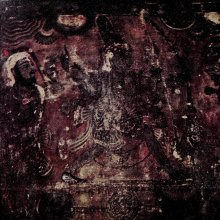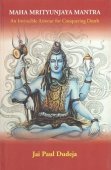Taittiriyasamhita, Taittirīyasaṃhitā, Taittiriya-samhita: 5 definitions
Introduction:
Taittiriyasamhita means something in Hinduism, Sanskrit. If you want to know the exact meaning, history, etymology or English translation of this term then check out the descriptions on this page. Add your comment or reference to a book if you want to contribute to this summary article.
Images (photo gallery)
Languages of India and abroad
Sanskrit dictionary
Source: DDSA: The practical Sanskrit-English dictionaryTaittirīyasaṃhitā (तैत्तिरीयसंहिता).—the Saṃhitā of the T., chief recension of the Black Yv.
Taittirīyasaṃhitā is a Sanskrit compound consisting of the terms taittirīya and saṃhitā (संहिता).
Source: Cologne Digital Sanskrit Dictionaries: Cappeller Sanskrit-English DictionaryTaittirīyasaṃhitā (तैत्तिरीयसंहिता).—[feminine] the Saṃhitā of the Taittirīyas (i.e. the black Yajurveda).
Source: Cologne Digital Sanskrit Dictionaries: Aufrecht Catalogus Catalogorum1) Taittirīyasaṃhitā (तैत्तिरीयसंहिता) as mentioned in Aufrecht’s Catalogus Catalogorum:—[Mackenzie Collection] 3. Io. 1701. 1702. Oxf. 376^b. Paris. (Gr. I. Ii). Haug. 11. 12. 53. Np. V, 144. Brl. 8. Burnell. 5^a. Mysore. 1. Oppert. 44. 7987. Ii, 1316. 5675. 7576. W. 1430. 1431. Peters. 2, 175. 176. Sb. 66.
—[commentary] Oppert. 7312. Ii, 2270. 3662.
—[commentary] by Bālakṛṣṇa. Sūcīpattra. 56.
—[commentary] Jñānayajña by Bhāskaramiśra. B. 1, 20 ([fragmentary]). Brl. 12. 13. Burnell. 6^a. Mysore. 1. Oppert. 4032. 4987. Ii, 533. 5772. 7883. 7888. 8555. 8560. Rice. 58.
—[commentary] by Sāyaṇa. Io. 1325 ([fragmentary]). 1857 ([fragmentary]). Khn. 2. B. 1, 12. Brl. 14. 15. Mysore. 1. Poona. Ii, 247-51. Oppert. 1548. 1549. 2201. Ii, 534. 1110. 1812. 4344. 6386. 6944. 7430. 7577. 7869. 8563. 8576. 8926. 9081. 10349. W. 1432-37. Sb. 68. Jaṭāpāṭha. Sb. 68. Prātiśākhya. [Mackenzie Collection] 7. Oxf. 356^a. Khn. 8. Burnell. 5^b. Oppert. 7986. Rice. 10. W. 1445. Bühler 553.
—[commentary] Tribhāṣyaratna. [Mackenzie Collection] 7. Oxf. 384^b. L. 3. Khn. 8. Np. Vi, 14. Brl. 8. Burnell. 5^b. Lahore. 2. Oppert. 993. 1461. 2135. 2344. 4305. 6739. 7139. 7189. 7997. Ii, 755. 1079. 1325. 4642. 5205. 6288. 6837. 7383. 7957. 8557. 8642. 9036. 9881. W. 1446. Bühler 553. Tribhāṣyaratnāvalī. Oppert. Ii, 1868.
2) Taittirīyasaṃhitā (तैत्तिरीयसंहिता):—
—[commentary] by Sāyaṇa. add Burnell. 7^b. Prātiśākhya. read Oxf. 386^a. Rice. 12.
3) Taittirīyasaṃhitā (तैत्तिरीयसंहिता):—Gb. 1. Stein 5 (kāṇḍa 2).
—[commentary] by Sāyaṇa. Cs. 44. Stein 5. Prātiśākhya. Gb. 15.
—[commentary] Tribhāṣyaratna by Soma. Gb. 16. Gov. Or. Libr. Madras 33.
4) Taittirīyasaṃhitā (तैत्तिरीयसंहिता):—Cs. 594-600 (pada). Hz. 636 (pada). Ulwar 53 (Saṃhitāpāṭha). 54 (pada).
—[commentary] by Bhaṭṭa Bhāskara. Hz. 310 (first kāṇḍa).
—[commentary] by Sāyaṇa. Cs. 44 (7). 554 (up to 5, 4, 12 inc.). 601 (5). Hz. 100 (inc.). 255 (two prapāṭhaka). 292 (up to the seventh prapāṭhaka). 646. Ulwar 55 (sixth kāṇḍa wanting).
5) Taittirīyasaṃhitā (तैत्तिरीयसंहिता):—As p. 77. Ak 18. 19 (Kāṇḍa 2. 3 Prapāṭhakāḥ). 20 (pada. Kāṇḍa 1, Prapāṭhaka 1 und 2). 21 (pada. Kāṇḍa 6, Prapāṭhaka 1-4 and 5 inc.). 22 (Kāṇḍa 7, Prapāṭhaka 1). Hz. 711 (pada, sixth Kāṇḍa missing). 712 (second Kāṇḍa). 731 (Kāṇḍa 5-7). 733 (first Aṣṭaka). 782 (pada. Kāṇḍa 2. 3). 783 (Kāṇḍa 6). Śg. 2, 3 (Kāṇḍa 6. 7). Whish 191. C. by Bhaṭṭa Bhāskara. Śg. 1, 1 (inc). 2, 4-8 p. 141 (Kāṇḍa 1. 5. 6. 7). C. by Sāyaṇa. As p. 77 (8 Mss. containing different Adhyāyāḥ except the sixth). Hz. 715 (Kāṇḍa 1). Śg. 1, 2. 3 (both inc.). Taittirīyasaṃhitākāṇḍānukramaṇikāvivaraṇa. Hpr. 2, 29. Prātiśākhya. Whish 37, 1. C. Tribhāṣyaratna. As p. 76 (4 Mss). Hz. 1278. 1430. Whish 37, 2. Taittirīyamantrapraśna. Śg. 1, 4. Taittirīyāruṇa. Śg. 2, 10. 11.
Source: Cologne Digital Sanskrit Dictionaries: Monier-Williams Sanskrit-English DictionaryTaittirīyasaṃhitā (तैत्तिरीयसंहिता):—[=taittirīya-saṃhitā] [from taittirīya > taittira] f. the Saṃhitā of the T°s (chief recension of the Black Yv., on the origin of which, [Viṣṇu-purāṇa iii, 5, 1-29] has the following legend: the Yv. was first taught by Vaiśampāyana to 27 pupils, among whom was Yājñavalkya; subsequently V. being offended with Y. bade him disgorge the Veda committed to him, which he did in a tangible form; whereupon the older disciples of V. being commanded to pick it up, took the form of partridges, and swallowed the soiled texts, hence named ‘black’; the other name taittirīya referring to the partridges. Y. then received from the Sun a new or white version of the Yv., called from Y.’s [patronymic] vājasaneyin).
[Sanskrit to German]
Sanskrit, also spelled संस्कृतम् (saṃskṛtam), is an ancient language of India commonly seen as the grandmother of the Indo-European language family (even English!). Closely allied with Prakrit and Pali, Sanskrit is more exhaustive in both grammar and terms and has the most extensive collection of literature in the world, greatly surpassing its sister-languages Greek and Latin.
See also (Relevant definitions)
Partial matches: Taittiriya, Samhita.
Full-text (+4105): Manthilava, Aprayaja, Asuvargya, Vishvadava, Kirsha, Purushakunapa, Luksha, Sahayashas, Acarmaka, Navacchadi, Palvalya, Apombhana, Aprajasya, Purastatpravana, Purushanishkrayana, Hritamukhin, Vishvalopa, Amridaya, Atatavin, Gatamanas.
Relevant text
Search found 60 books and stories containing Taittiriyasamhita, Taittirīyasaṃhitā, Taittiriya-samhita, Taittirīya-saṃhitā; (plurals include: Taittiriyasamhitas, Taittirīyasaṃhitās, samhitas, saṃhitās). You can also click to the full overview containing English textual excerpts. Below are direct links for the most relevant articles:
Women in the Atharva-veda Samhita (by Pranab Jyoti Kalita)
5e. Practice of Polygamy and Polyandry < [Chapter 3 - The Familial and Social Life of Women in the Atharvaveda]
2. Goddess Apsarases < [Chapter 4 - Female Deities and the Glorification of Women in the Atharvaveda]
5. Women in the Atharvavedic Society (a): Marriage < [Chapter 3 - The Familial and Social Life of Women in the Atharvaveda]
Mimamsa interpretation of Vedic Injunctions (Vidhi) (by Shreebas Debnath)
Chapter 1.1 - The Utility of the Pūrva Mīmāṃsā
Chapter 6.1 - Special Aspects of Darśapūrṇamāsayāga
Rivers in Ancient India (study) (by Archana Sarma)
1. The Vedic Literature < [Chapter 1 - Introduction]
1(i). Sarasvatī and her association with other Gods and Goddesses < [Chapter 2 - The Rivers in the Saṃhitā Literature]
4. The river Sindhu in the Ṛgveda-saṃhitā < [Chapter 2 - The Rivers in the Saṃhitā Literature]
Soma in Vedic Mythology and Ritual (study) (by Anjana Chakraborty)
Chapter 3(a) - Rituals of Somayaga (introduction)
Chapter 1(c) - Association of Soma with other Gods
Chapter 4 - The Synchronization of Rituals and Myths of Soma
Bharadvaja-srauta-sutra (by C. G. Kashikar)
Rudra-Shiva concept (Study) (by Maumita Bhattacharjee)
3. Rudra in the Taittirīya-saṃhitā (Introduction) < [Chapter 2 - Rudra-Śiva in the Saṃhitā Literature]
2. Vājasaneyi-saṃhitā (d): Tryambaka Homa < [Chapter 2 - Rudra-Śiva in the Saṃhitā Literature]
Related products


